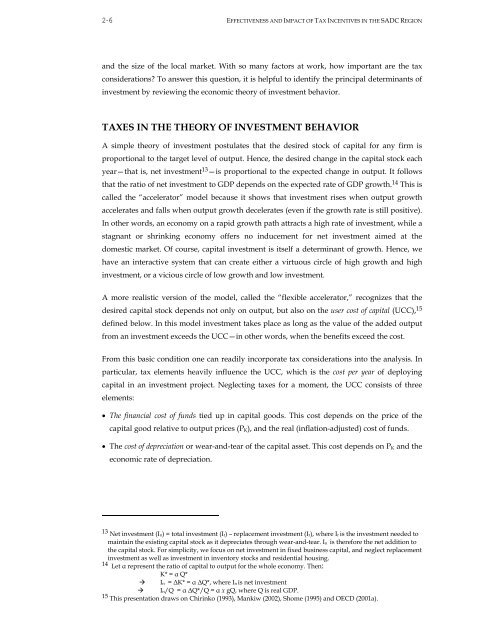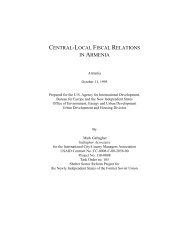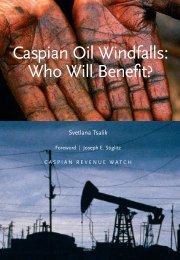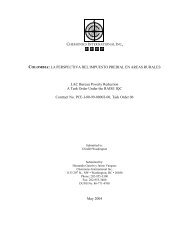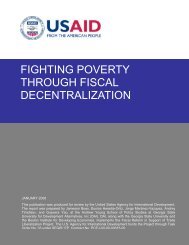Effectiveness and Economic Impact of Tax Incentives in the SADC ...
Effectiveness and Economic Impact of Tax Incentives in the SADC ...
Effectiveness and Economic Impact of Tax Incentives in the SADC ...
You also want an ePaper? Increase the reach of your titles
YUMPU automatically turns print PDFs into web optimized ePapers that Google loves.
2-6 EFFECTIVENESS AND IMPACT OF TAX INCENTIVES IN THE <strong>SADC</strong> REGION<br />
<strong>and</strong> <strong>the</strong> size <strong>of</strong> <strong>the</strong> local market. With so many factors at work, how important are <strong>the</strong> tax<br />
considerations? To answer this question, it is helpful to identify <strong>the</strong> pr<strong>in</strong>cipal determ<strong>in</strong>ants <strong>of</strong><br />
<strong>in</strong>vestment by review<strong>in</strong>g <strong>the</strong> economic <strong>the</strong>ory <strong>of</strong> <strong>in</strong>vestment behavior.<br />
TAXES IN THE THEORY OF INVESTMENT BEHAVIOR<br />
A simple <strong>the</strong>ory <strong>of</strong> <strong>in</strong>vestment postulates that <strong>the</strong> desired stock <strong>of</strong> capital for any firm is<br />
proportional to <strong>the</strong> target level <strong>of</strong> output. Hence, <strong>the</strong> desired change <strong>in</strong> <strong>the</strong> capital stock each<br />
year—that is, net <strong>in</strong>vestment 13 —is proportional to <strong>the</strong> expected change <strong>in</strong> output. It follows<br />
that <strong>the</strong> ratio <strong>of</strong> net <strong>in</strong>vestment to GDP depends on <strong>the</strong> expected rate <strong>of</strong> GDP growth. 14 This is<br />
called <strong>the</strong> “accelerator” model because it shows that <strong>in</strong>vestment rises when output growth<br />
accelerates <strong>and</strong> falls when output growth decelerates (even if <strong>the</strong> growth rate is still positive).<br />
In o<strong>the</strong>r words, an economy on a rapid growth path attracts a high rate <strong>of</strong> <strong>in</strong>vestment, while a<br />
stagnant or shr<strong>in</strong>k<strong>in</strong>g economy <strong>of</strong>fers no <strong>in</strong>ducement for net <strong>in</strong>vestment aimed at <strong>the</strong><br />
domestic market. Of course, capital <strong>in</strong>vestment is itself a determ<strong>in</strong>ant <strong>of</strong> growth. Hence, we<br />
have an <strong>in</strong>teractive system that can create ei<strong>the</strong>r a virtuous circle <strong>of</strong> high growth <strong>and</strong> high<br />
<strong>in</strong>vestment, or a vicious circle <strong>of</strong> low growth <strong>and</strong> low <strong>in</strong>vestment.<br />
A more realistic version <strong>of</strong> <strong>the</strong> model, called <strong>the</strong> “flexible accelerator,” recognizes that <strong>the</strong><br />
desired capital stock depends not only on output, but also on <strong>the</strong> user cost <strong>of</strong> capital (UCC), 15<br />
def<strong>in</strong>ed below. In this model <strong>in</strong>vestment takes place as long as <strong>the</strong> value <strong>of</strong> <strong>the</strong> added output<br />
from an <strong>in</strong>vestment exceeds <strong>the</strong> UCC—<strong>in</strong> o<strong>the</strong>r words, when <strong>the</strong> benefits exceed <strong>the</strong> cost.<br />
From this basic condition one can readily <strong>in</strong>corporate tax considerations <strong>in</strong>to <strong>the</strong> analysis. In<br />
particular, tax elements heavily <strong>in</strong>fluence <strong>the</strong> UCC, which is <strong>the</strong> cost per year <strong>of</strong> deploy<strong>in</strong>g<br />
capital <strong>in</strong> an <strong>in</strong>vestment project. Neglect<strong>in</strong>g taxes for a moment, <strong>the</strong> UCC consists <strong>of</strong> three<br />
elements:<br />
•<br />
•<br />
The f<strong>in</strong>ancial cost <strong>of</strong> funds tied up <strong>in</strong> capital goods. This cost depends on <strong>the</strong> price <strong>of</strong> <strong>the</strong><br />
capital good relative to output prices (PK), <strong>and</strong> <strong>the</strong> real (<strong>in</strong>flation-adjusted) cost <strong>of</strong> funds.<br />
The cost <strong>of</strong> depreciation or wear-<strong>and</strong>-tear <strong>of</strong> <strong>the</strong> capital asset. This cost depends on PK <strong>and</strong> <strong>the</strong><br />
economic rate <strong>of</strong> depreciation.<br />
13 Net <strong>in</strong>vestment (In) = total <strong>in</strong>vestment (It) – replacement <strong>in</strong>vestment (Ir), where Ir is <strong>the</strong> <strong>in</strong>vestment needed to<br />
ma<strong>in</strong>ta<strong>in</strong> <strong>the</strong> exist<strong>in</strong>g capital stock as it depreciates through wear-<strong>and</strong>-tear. In is <strong>the</strong>refore <strong>the</strong> net addition to<br />
<strong>the</strong> capital stock. For simplicity, we focus on net <strong>in</strong>vestment <strong>in</strong> fixed bus<strong>in</strong>ess capital, <strong>and</strong> neglect replacement<br />
<strong>in</strong>vestment as well as <strong>in</strong>vestment <strong>in</strong> <strong>in</strong>ventory stocks <strong>and</strong> residential hous<strong>in</strong>g.<br />
14 Let α represent <strong>the</strong> ratio <strong>of</strong> capital to output for <strong>the</strong> whole economy. Then:<br />
K* = α Q*<br />
In = ∆K* = α ∆Q*, where In is net <strong>in</strong>vestment<br />
In/Q = α ∆Q*/Q = α x gQ, where Q is real GDP.<br />
15 This presentation draws on Chir<strong>in</strong>ko (1993), Mankiw (2002), Shome (1995) <strong>and</strong> OECD (2001a).


